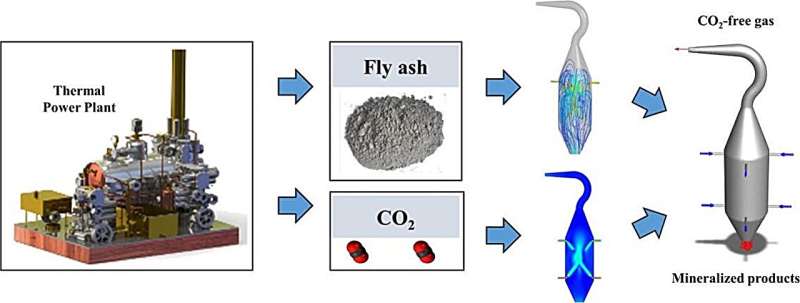
JUNE 14, 2024 by TranSpread
Collected at: https://techxplore.com/news/2024-06-mineralizing-emissions-advanced-reactor-capture.html
In advancing sustainable waste management and CO2 sequestration, researchers have crafted reactors that mineralize carbon dioxide with fly ash particles. This avant-garde technique is set to offer a sustainable and lasting solution to the pressing issue of greenhouse gas emissions, repurposing an industrial by-product in the process.
The relentless march of industrialization has corresponded with a surge in CO2 emissions, a key driver of global warming.
Existing carbon capture, utilization, and storage (CCUS) technologies grapple with issues of efficiency and cost. Fly ash, a coal combustion by-product, offers a promising avenue for CO2 mineralization, turning waste into a resource and curtailing emissions.
Yet, prevailing reactor designs struggle to achieve the desired synergy between gas-particle interactions and operational efficacy. These hurdles underscore the imperative for an in-depth investigation into innovative reactor configurations and operational fine-tuning.
Shanghai Jiao Tong University’s research on fly ash mineralization reactors was published in the Energy Storage and Saving journal on May 7, 2024.
The study, subjected to meticulous computational optimization, unveils a pioneering reactor design anticipated to escalate the efficacy of CO2 capture and mineralization.
The research introduces a duo of reactor designs, each meticulously sculpted for CO2 mineralization via fly ash, with computational fluid dynamics at the helm of optimization. The impinging-type inlet design stands out for its capacity to amplify interfacial interactions, extending particle dwell times and significantly augmenting mineralization rates.
The quadrilateral rotary-style inlet, conversely, champions streamlined flow for comprehensive mixing and reaction efficacy. A rigorous exploration of operational parameters—flue gas velocity, carrier gas velocity, and particle velocity—yielded optimal ranges that promise to propel reactor performance to new heights, ensuring efficient CO2 mineralization and phase separation post-reaction.
Dr. Liwei Wang, the study’s principal investigator, said, “Our findings mark a significant leap forward in carbon capture and utilization technologies. By refining reactor designs and operational parameters, we’ve achieved a substantial leap in CO2 mineralization efficiency.
“This work is not only a boon to sustainable waste management but also presents a pragmatic strategy for curtailing industrial carbon emissions, aligning with global climate action initiatives.”
The research bears profound implications for coal-fired power plants, offering a transformative use for the fly ash they generate. By channeling this by-product into CO2 mineralization, the study paves the way for diminished carbon emissions and a reduction in the environmental burden of fly ash disposal.
The broader applications of this research are expansive, presenting a harmonious solution to waste management and CO2 sequestration that could very well redefine CCUS technology approaches.
More information: Duoyong Zhang et al, Simulation Design and Optimization of Reactors for Carbon Dioxide Mineralization, Energy Storage and Saving (2024). DOI: 10.1016/j.enss.2024.04.002

Leave a Reply